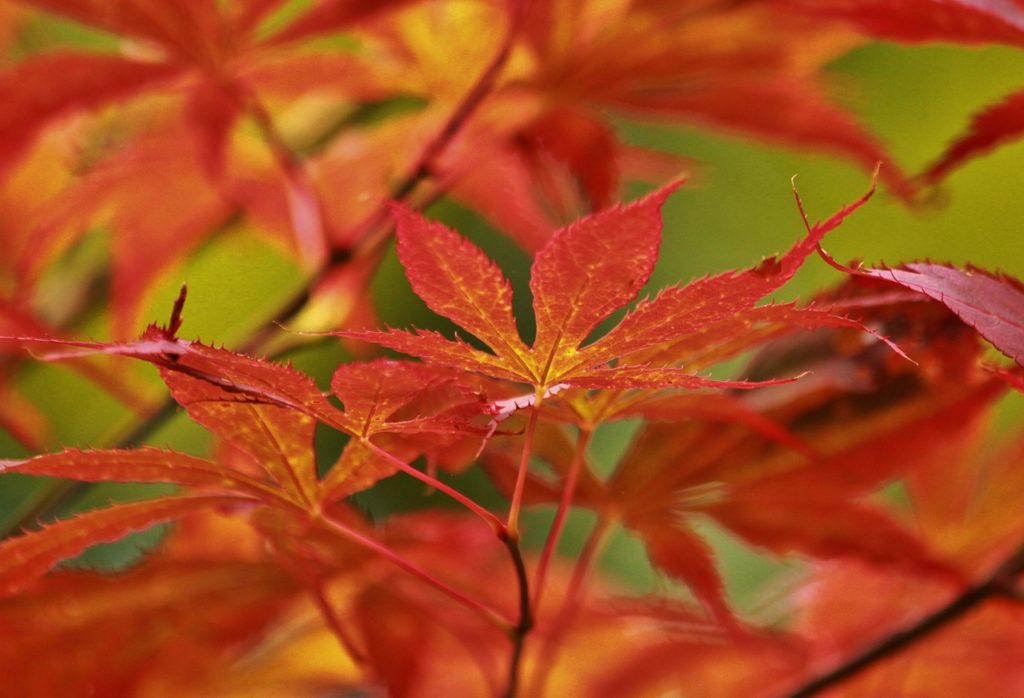This is the second half of a two part series on Japanese maple. The following examines the pruning and cultivation of the plant, as well as its damaging agents and pests, allergenic potential, and many uses.
Introduction
Japanese maple (Acer palmatum), also called smooth Japanese maple, or mountain maple, is a species of woody plant indigenous to Japan, China, Korea, eastern Mongolia, Taiwan, and southeast Russia. Due to its graceful habit, and striking foliage, Japanese maple has become a staple in many landscapes and gardens. It can also be found growing as an understory plant in shady woodlands. In Europe, the first specimen of Japanese maple reached England in 1820. It was named Acer palmatum by the Swedish botanist Carl Peter Thunberg, reflecting the hand-like shape of its leaves. Many different cultivars of Japanese maple are selected and grown worldwide for their variety of forms, leaf shapes, and colors.
Pruning
On Japanese maple, pruning is seldom necessary, except to remove any dead, diseased, or damaged branches. Japanese maple can be pruned to maintain a particular shape or size, as well as to thin out interior branches. When properly pruned, trees rapidly callus over any wounds. Japanese maple should not be pruned like a hedge, but methodically shaped. It is best pruned when fully dormant, a period that lasts from November to January. If pruned in spring, summer, or early fall, Japanese maple will bleed sap.
Cultivation
The cultivation of Japanese maple has occurred over three centuries. More than 1,000 cultivars are chosen for their specific characteristics, which are propagated by asexual reproduction. Most cultivars are artificially selected from the seedlings of pollinated maples, and propagated using a technique called grafting. Some cultivars can be propagated using other methods such as budding, cutting, layering, or tissue culture. Not all cultivars are available in the Western world; many have disappeared over time. Fortunately, given the popularity of the plant, new cultivars are developed each decade.
Many cultivars are smaller and less vigorous than the parent species. The variance in their genetic traits is what makes them so appealing. Cultivars develop in a multiplicity of forms. They may have upright, weeping, or cascading growth habits. They may also take on a broom-like appearance. Other cultivars are smaller, and qualify as large shrubs. Many cultivars have characteristics that are influenced by a particular season. These can include leaf or bark coloration, as well as the shape and color of samaras.
Some cultivars are difficult to distinguish from others. Identical cultivars are often assigned different names, while cultivars with disparate traits are given the same name. Several cultivar groups have been bred to such an extent that they resemble the parent species. Numerous dark red Japanese maples are sold under the names ‘Atropurpureum’ and ‘Bloodgood’. Cultivars with lace-like foliage are sold under the names ‘Dissectum’, ‘Filigree’, and ‘Laceleaf’.
Similar Species
Sometimes the term ‘Japanese maple’ is used to describe other species that are native to Japan, China, and Korea. These include downy Japanese maple (Acer japonicum), Korean maple (Acer pseudosieboldianum), fullmoon maple (Acer shirasawanum), Siebold’s maple (Acer sieboldianum), and trident maple (Acer buergerianum).
Damaging Agents & Pests
Japanese maple can be prone to leaf scorch when exposed to high winds, or excessive sunlight. Trees with diseased or inadequate root systems are more susceptible to leaf scorch. If affected, trees will develop light brown or tan dead areas between leaf veins. Symptoms may appear on all parts of the tree, or on the section of the tree facing the sun or wind. Scorching due to dry soil can be offset through sufficient watering.
Japanese maple can suffer from nutrient deficiencies. The most common deficiency is that of manganese. When affected, leaves turn yellow or yellowish-green, while leaf veins become dark green. Implanting a capsule containing a manganese source in the trunk can help alleviate the symptoms. Soil with an excess of nitrogen can promote overly vigorous growth that is prone to pathogens.
Specimens that are grown in containers may be susceptible to vine weevil larvae. In landscape and forested settings, Japanese maple can incur scale insect damage, particularly from cottony maple scale. The insect forms a cottony mass on the lower sides of branches. Scale insects can be controlled using horticultural oil sprays. Well-timed applications can eradicate the scale larvae.
Aphids may be numerous at times. Large aphid populations can cause premature leaf drop. A noticeable symptom of heavy aphid infestation is the presence of a sticky substance called honey dew on the lower leaves of the tree. Aphids can be effectively controlled through spray applications. Biological controls can also be utilized. Predatory insects will naturally reduce aphid populations.
If a specimen is stressed, or developing in poor site conditions, it can attract wood borers. Controlling borers involves maintaining plant vigor. Chemical applications can be effective on isolated trees, but widespread infestations are more difficult to combat. Proper control requires identification of the borer infesting the tree, following by several insecticide applications.
Japanese maple tends to leaf out early, rendering young leaves vulnerable to damage resulting from spring frosts.
Allergenic Potential
Japanese maple has received an OPALS* allergy scale rating of five, making it moderately allergenic.
*The OPALS allergy scale, and its associated ratings are derived from Thomas Leo Ogren’s seminal book: Allergy-Free Gardening: The Revolutionary Guide to Healthy Landscaping.
Uses
For centuries, Japanese horticulturalists have developed cultivars from maples found in Japan, Korea, and China. Numerous cultivars are available commercially in retail stores and garden centers across Europe and North America. Cultivars with red leaves are the most popular, followed by cascading green shrubs with deeply dissecting leaves.
Japanese maple is a popular selection for bonsai and gardening enthusiasts. It has also used as a subject in other art forms. When the Swedish doctor and botanist Carl Peter Thunberg traveled to Japan in the eighteenth century, he left having recorded drawings of a small Japanese maple that would prove influential to the high art of oriental gardening.
Japanese maple is an ideal plant for growing in containers. For the best results, plant seeds in a loam-based, well-drained compost with an abundance of organic matter. Ensure the compost remains consistently moist, though avoid drenching the compost completely. Throughout spring and early summer, apply a slow-release fertilizer, or liquid feed to the compost to encourage seed germination. Maples that emerge will need to be transferred to slightly larger containers every few years. April or September are ideal months for transplanting.
The branches and leaves of Japanese maple are prepared and used as a treatment in traditional Chinese medicine. On the Chinese calender, October is represented by the Japanese maple leaf. In Japan, the leaves are used to create bouquets.
Squirrels and chipmunks are fond of Japanese maple seeds. The seeds, buds, and flowers are consumed by grouse, quail, ducks, and many songbirds.
Additional Resources
https://www.arborday.org/TREES/treeguide/TreeDetail.cfm?ItemID=866


